Part 8: Viaduct traffic, Journaled
- History written by the whiners
- 'Battle of the Bridge'
- Bayview slip lane
- Westward city growth gets the wheel squeaking again
- Viaduct repairs 1920s to 1950s
- Wellington Bridge is Falling Down 1960s
- New Wellington Viaduct to be built
- Wellington Street Officially Severed
- 'Replacement' viaduct will disconnect Wellington
- Reaction to Wellington disconnection
- Demolition of the Wellington Street Viaduct
- References
The last connection change was back in Part 4 when the Wellington Street Viaduct was built in 1909 (overtop an existing route). As it happens, the next major change to Wellington Street that we'll look at is when the viaduct was replaced.
The Viaduct gets an entire post thanks to the Ottawa Journal's obsession with its role as a bottleneck for afternoon rush-hour traffic.1
History written by the whiners
In the late 1940s, "as post-war traffic densities zoomed to new highs (which are being exceeded yearly), Wellington street viaduct became the bottleneck which throttled westbound traffic during the afternoon rush of office workers heading home."2 This was largely because Wellington and Carling were effectively the only streets crossing the tracks and continuing to the west end of the city, plus Wellington connected directly from downtown. Wellington was further burdened by traffic continuing eastbound from Scott via Bayview (in particular commercial traffic looking to avoid the streetcars in Hintonburg) and by traffic continuing westbound from Somerset.1
As can be seen in this May 1960 aerial photo, the Wellington Street viaduct on the right is the only connection from the west end of town on this side of the Ottawa River. Scott Street cuts off just at the bottom of the photo, with the various rail yards separating Hintonburg and Mechanicsville from central Ottawa.
In 1949-1950, the Ottawa Journal newspaper ran an intensive campaign to relieve congestion on the Wellington Street viaduct, complaining about traffic commute times from and to the west end.2 While the Journal was very loud on the subject, I did not see much on the topic from other sources. In other words, history may have been written by the whiners. Nevertheless, their campaign gives us some insight into the mind of a regular user of Wellington Street in 1950.
Given the liberal use of passive voice and unnamed sources, I speculate that some influential person at the Journal lived in the west end and wanted to couch their personal vendetta in the trappings of a public outcry. The over-the-top descriptions of the Wellington Street viaduct as the "whetstone of the keenest profanity ever honed,"3 for example, appeared prominently over many months on The Third Page, which otherwise contained hard news stories. An earlier example was the October 1949 photo and caption at the top of this post.
On June 6, 1950, an unnamed "prominent West End resident" is quoted in the article below saying that Wellington "should be called Capital Sclerosis" and that the afternoon commute is "one of the most harrowing 25 minutes in [any west end commuter's] day."4
This "prominent West End resident" might have been Ron Smith, who drew the "Five O'Clock Crawl" map in a spread that took the entire top half of Page Three on the June 16, 1950, edition of the Journal. "Test runs were made" of the seven different ways to get from Bank and Wellington to Carling and Island Park Drive, of which Wellington took the longest, and "the best time of 16 minutes ... is much too slow for a distance of three miles." They conclude that it is faster to cross the Chaudière and Champlain bridges and take the Aylmer Road than to take Wellington.5
There were some indications of traffic congestion on the Wellington viaduct other than the Journal's editorial crusade. For example, when the Federal District Commission built the Mackenzie-King Bridge and twinned Albert and Slater to carry its traffic, there was an expectation that the viaduct would be widened (though it's not indicated by whom),6 and the Ottawa Citizen's coverage of Gréber's Capital Plan indicated various "short range highway operations" to relieve pressure from Wellington Street, including "a direct approach [for Highways 15 and 17] by way of an extension of Scott street through to Wellington," and what would become the Queensway to divert non-local traffic off of Wellington/Rideau7
'Battle of the Bridge'
While the viaduct was widely acknowledged to be in physical disrepair, as evidenced by the many repairs discussed a couple of sections down, the Journal's editorials pushed for the Wellington Street viaduct to be painted with three lanes, two westbound and one eastbound, and the June 16 feature (above) included an illustration of this. Three days later, in a meeting lasting only fifteen minutes, the Civic Traffic Committee approved of the idea.8
However, on June 27, 1950, the City's Board of Control nixed the idea, concluding that the 30-foot viaduct was too narrow for three lanes (plus a four foot edge buffer given the frailty of the railings), deciding instead to paint a single white line down the centre. In reporting this decision, the Journal defensively noted that the 36-foot wide Laurier bridge had been painted for four lanes two years prior and saying "the Wellington Bridge will remain what police say is the city's worst traffic bottleneck."9
The matter continued to receive Controllers' attention over the summer months, with Public Works Commissioner J. H. Irvine recommending at a 1950-06-27 meeting that the viaduct be made one-way westbound,10 and Mayor Bourque and Controller Coulter wanting another look at the three-lane option (including narrowing the sidewalk), citing the Journal's photo (above) of four cars sqeezing abreast on the viaduct.11
Those against, including Controller Tardif: "Eventually, he said, there would be a bridge further north across Lazy Bay and much of the traffic would follow the Federal District road across at this point."11
The Civic Traffic Committee on 1950-07-31 "agreed unanimously that Inspector Callaghan's original recommendation for a three-lane traffic (sic) should be tried for a month,"12 and was once again rebuffed the next day by the Board of Control, who instead proposed making Wellington westbound and Somerset eastbound from 4:30 to 6:30 p.m.13 (morning rush hour was more spread out so did not require similar measures2)
When City Council "finally" agreed to make changes by making the viaduct one-way westbound for the afternoon commute (Council agreed on 1950-08-08 to try this for a month,14 but it doesn't look like anything happened before a permanent by-law came into force at the end of September15), the Journal's articles, now signed by David J. Ghent, took substantial credit for their role in the "Battle of the Bridge":2
After many months of inaction, City Council last Spring began reading a series of Journal stories, studying Journal "the proof-is-in-the-picture" photographs, and poring over Journal traffic diagrams. They also began listening to the City Traffic Committee and the Traffic Branch.Despite celebrating this decision, the Journal hinted that they thought it was insufficient by reprinting their photo showing four cars fitting side-by-side on the crest of the Viaduct:2
... This new regulation is now law. It was approved by the Department of Highways in the Provincial Parliament buildings at Toronto last Friday.
The "solution to the 'Five O'Clock Rush'" went into effect on Monday October 2, 1950 (even though by By-Law didn't come into force until two weeks later16), and would be in effect every afternoon except Sundays. "Traffic lights at Wellington and Bayswater, Preston and Somerset and Somerset and Wellington will be turned off during the two-hour one-way period, and constables be (sic) on point duty at the intersections."17
On the first day the constable had to stop six OTC buses and a couple other municipal vehicles whose operators tried to go the wrong way, but otherwise things went smoothly. "At no time between 4.30 and 6.30 were cars on Wellington street travelling nose-to-tail farther east than the east end of the bridge. Last week they were bumper-to-bumper right into Centre Town."18
With the Wellington viaduct crusade won, the Journal didn't skip a beat: "those concerned with Ottawa's traffic might well turn their attention to other pressing problems. Not least of these ... is allowing parking on both sides of narrow streets."19
Bayview slip lane
The City continued to tweak the viaduct traffic, having already expropriated land to permit a 16-foot wide turning lane from Wellington westbound to Bayview northbound.20 Inspector Callaghan said "We hope to swing two lanes of traffic north from the viaduct to Scott street. This will allow any motorist to get to the west across the bridge at near maximum city speeds."17 The Journal referred to this slip lane as "the last installment of the Story of the Road to the West".21
The City's Traffic Committee heard the next month, Noveber 1950, that work on this slip lane was already underway,22 three days before a one-paragraph Journal article indicated that City Council approved a $2,000 expenditure for the construction of the 'recently expropriated' land.23 I couldn't find more details clarifying the apparent discrepancy in these dates.
In 1957, further adjustments to the Wellington-Bayview-Scott connection were considered, but Traffic Director Rankin made it clear that the only solution to the traffic problem would be "to build another viaduct to lead straight into Scott street."24 Despite this knowledge, in 1962 a $7,000 project expropriated two residences to construct an additional lane on Bayview and an even wider slip lane, shown below shortly before the expected completion date of 1962-08-10.25
The GeoOttawa aerial maps for 1958 (top) and 1965 (bottom) show a much wider curve but it still looks like it's only one lane wide.
Westward city growth gets the wheel squeaking again
In July, 1953, less than three years after the "the last installment of the Story of the Road to the West",21 the Journal turned its sights once again on the viaduct in an editorial: "Traffic congestion in Ottawa's West End is something new, and comes from a very heavy increase in both residential population, as represented by thousands of new homes, and working population as represented by the Government buildings in Tunney's Pasture and the development of offices and light industries on Wellington street and Richmond road." The ongoing work to repave Scott Street made traffic on Wellington worse, but it was the Viaduct itself that was inadequate. "Nothing done west of the bridge can make up for its shortcomings. Some day it must be replaced by a structure twice as wide, but that will be a costly project and there are works more pressing."26
Indeed, the prior January, the Ottawa Transit Commission, whose eastbound buses were running five to seven minutes late when detoured over the Somerset Street bridge, wanted the afternoon westbound restriction on the viaduct postponed to 5:00 p.m. to permit "faster movement of workers from the Tunney's Pasture Bureau of Statistics Building... DBS oficials (sic) had changed their working hours [to 4.30pm] so that the OTC could provide extra buses. But the advantage was being lost through the Bayview Road-Somerset Street bottleneck."27
The Journal's Third Page joined the fight in November, observing that four police officers were required to direct morning traffic through the area. "The traffic men" said that making the viaduct one-way eastbound in the mornings wouldn't help because the traffic can't disperse onto different routes like westbound traffic can, and that "it won't get better until the FDC extends Scott with the continuation of the parkway planned for the sweep of Nepean Bay.":28
The Citizen joined in the fight with an editorial in February, 1954, calling for "a new overpass to connect Scott Street (which has been improved and now draws off a large volume of east-west traffic) with Wellington in the neighbourhood of Preston. This admittedly would be more costly than the proposed Lyon Street overpass, but the need for it appears to be more urgent." The same editorial sought widening of Carling, the other "serious bottleneck" for west-end commuters.29
A May, 1954, Journal editorial used the occasion of the opening of Freiman's Carling Avenue department store to propose widening Carling Avenue to four lanes, using land from the Experimental Farm, "while a study is made of ways (and the cost) of relieving the situation at the Wellington bridge. Nothing is to be gained by delay—every new development in the West End, each house built, every new family located, makes present inadequacies in communications stand out still more clearly."30
In August, 1960, the daily afternoon one-way traffic on the viaduct was extended to start half an hour earlier, from 4:30 p.m. to 6:00 p.m., instead of starting at 5:00 p.m.,31 This was intended to reduce congestion at Wellington and Albert, but also had the effect that civil servants at Tunney's Pasture "were forced to drive through traffic-jammed two-way Somerset Street in order to reach their homes in central and eastern Ottawa."32
Viaduct repairs 1920s to 1950s
Aside from the traffic congestion, the Wellington Street Viaduct's lack of physical integrity was already documented. In May, 1921, a twelve-ton truck loaded with stone broke a three foot hole in the bridge with its rear wheels.33 City Council authorized $3,500 for repairs which commenced two days later. "The holes in the Wellington street viaduct" were patched with boards "and then the whole flooring will be covered with three inch planking"34 temporarily until the City learns from the Dominion Railway Board how the estimated $30,000 cost of "permanent flooring" would be divided.33
As early as 1924, the condition was so poor that a million-dollar replacement bridge was anticipated (but not planned); however, the Chief of Police observed that "the viaduct was put in when all trains entering Ottawa shunted under this viaduct. Now only a few engines a day used this trackage," and therefore a level crossing should be considered for both the Wellington and Somerset viaducts.35
Moving forward to September, 1947, the Board of Trade said the Wellington Street Viaduct was a "menace and is out of date" in a report to City Council.36
In late December, 1948, a team of six C.P.R. Bridge and Building Department workers was removing worn stringers under the viaduct, when their scaffolding collapsed, injuring four of them. (Which reminds us that jurisdictional obstacles also impeded changes to the viaduct)37
When the viaduct "at last was undergoing repair" to its eastbound lanes in April, 1955, the west end saw the "longest, tightest traffic jam of months, worse even than the epic pre-Christmas storm tangle" described in part 6. The page 1 Journal article mentioned that the bridge "would have made a good proving groun[d] for tanks."38
The viaduct closed in the evenings for two weeks in June and July 195739,40 for repairs which were concisely described by Acting Works Director Frank Ayers to the Journal:41
For years, the wearing surface on the bridge has been patched and resurfaced so that latterly, the depth of asphalt has grown to eight inches.A newspaper notice advised the viaduct would be closed overnight for unspecified repairs on Wednesday, 1958-09-10.42
This "dead weight" has approached the maximum carrying capacity of the old span. To give temporary extra life to the viaduct, this asphalt and weight is being peeled off to the wooden timbers underneath.
New 2 x 4 timbers are being laid and a thin asphalt wearing surface will be applied on top of this new wood.
Approximate cost: $8,000.
An April, 1959, crash gives us a view of the railing described in Part 4. The sidewalk on the south side was concrete, so the boards seen here must have been part of the road deck (perhaps the pavement on top didn't extend all the way to the railings).43
Wellington Bridge is Falling Down 1960s
The 1960s saw continued reluctant extensions to the Wellington Street Viaduct's life. As City Council approved its $68M annual budget in March 1963, "All wanted to know when major repairs were going to be carried out and all were told as soon as feasible by Planning and Works Director Frank Ayers,"44 "it may take three or four years before [a new span] is built,"45 or possibly "another 'type of construction' when redevelopment is carried out in the area."44 Alderman St. Germain felt the Wellington span is much better state than the Pretoria Bridge,45 and suggested "steel plates cover gaping holes in pavement that can't be repaired in cold weather."44
In February, 1964, Ottawa City Council approved its first five-year capital spending plan, $91.2 million to cover a litany of projects up to 1968. The Wellington Street Viaduct was allocated $230,000 from the City (to be joined by $250,000 from the province)46,47 to "seek authority to accelerate replacement of the Wellington Street CPR overpass, to be ready for traffic in 1967" at a total projected cost of $950,000.48 The Journal's Page Three was filled with lists of projects, but only one photo—of its favourite viaduct:49
One of redevelopments referenced in the 1963 budget discussion is the City Centre building, whose zoning was approved in March 1964 (clearly, from the photo above, some of the warehouse bays were already constructed), one of many projects whose "builders are rushing to get their permits before the new building heights, parking and zoning control bylaw 68-63 comes into effect ... at the end of April."50 The building's north ramp is oddly shaped as it is because the site was constrained by the then-extant viaduct, as seen in this 1965 newspaper photo from the City Centre's new sturdy, concrete ramp looking at the ramshackle Viaduct.51
In October, 1964, the condition of the Wellington Street Viaduct had deteriorated to the point that vehicles driving over it (also over the St. Patrick Street Bridge) were limited to 12 tons, except for OTC buses.52 The June 1965 "Shake, Rattle and Roll" article51 alongside the photo above gives a harrowing description of the state of the viaduct, and a foreshadowing of the 1965 Ottawa-Hull Transportation Study:
"The Wellington street bridge over the old CPR viaduct is on its last legs.
Every time a car goes over, the old wooden structure shudders, and sometimes another chunk of the asphalt surfacing on the viaduct is knocked out of place. … Wood supports warped; the unpainted four - by - four framing splintered and twisted; gaping cracks in the planking sidewalk; iron guard - rails with what little paint remains peeling off — in some cases three distinct shades of civic spruce-up showing.
The artery is supposed to be one of the main routes in the Capital. It eventually wends past the Parliament Buildings themselves — one of the high-spots of any tourist's trip to Ottawa. … "We're always repairing it and patching it," city roadways engineer Al Johns told The Journal, "because of the wood basing the asphalt surfacing is always being knocked out of place because of vibrations caused by motor traffic."
However, the viaduct won't be in existence much longer, according to city traffic director Thor Neilsen. He would not expand on what any changes will bring.
Recommendations in the forthcoming Ottawa Transportation study, he told The Journal, will stay under his hat until the study is released to the press.
…
A suggestion that the viaduct will be knocked out of existence as a major traffic route when Wellington Street is linked up with the Parkway early next year "isn't too far off base," said Mr. Neilsen."
New Wellington Viaduct to be built
The five-year capital forecast published alongside the City of Ottawa's 1966 budget, approved February 28, anticipated $435,000 would be spent in 1967 for the City's share of the $950,000 cost to replace the viaduct.53,54
In September, 1966, the Board of Control approved $16,000 for the engineering study to be conducted by DeLeuw, Cather Ltd. "The bridge, which may overpass or underpass rail tracks depending on the cost, is a vital link between two freeways proposed in the Ottawa - Hull area transportation study."55 Construction "will begin as soon as possible"56 and be complete in 1968, according to N. H. Orr, design and special projects engineer for the City.57 This led to some speculation that the bridge would be demolished in 1967 to make way for the replacement along the same alignment.58,59
And not a moment too soon: Effective October 3rd, the Wellington Street Viaduct's weight limit was reduced from 12 tons to 10 tons, which meant that "buses on routes 51 and 52 will have to be diverted to the Somerset St. Bridge. ... we must ask you to bear with us as we adjust to comply with this emergency instruction."60 "Empty OTC buses which weigh a maximum of 10 tons will still take the viaduct to and from the OTC's Champagne Street garage," pleaded the Ottawa Transportation Commission in an informational advertisement.57
Despite the City claiming that "the old viaduct is completely safe unless a number of extremely heavy vehicles happened by coincidence to get on its main span at the same time" at the end of October,58 only a couple of weeks later "Traffic Director Keith McLean says no trucks with a carrying capacity over one ton will be allowed to use the viaduct."59,61
Indeed, despite the 1967 capital works budget being halved from the previous year62 (partly because lots of work was done in 1966 so downtown streets could be free of construction for Centennial tourists63), "the new Wellington Street bridge over the CPR tracks" was indeed funded as the year's marquee infrastructure project,64 the only budget item depicted in a photo:65
It wasn't until a Board of Control meeting a couple days after the budget was approved that it was decided for the new bridge to split Wellington Street. "The viaduct would connect Wellington Street, east of the present structure, with Scott Street at Bayview Road." Land costs for the new alignment would bump the budget up to $1 million.66 "The board was concerned about the effects of closing off Wellington Street, but it approved consultation on cost-sharing with federal officials after assurance final plans for the structure would come before the board again. Most of the land needed is owned by the CPR."67
'Replacement' viaduct will disconnect Wellington
All the way back in the late 1930s, preliminary studies by Jacques Gréber "likewise envisaged the linking up of Scott Street and Wellington Street providing a new westerly outlet toward Westboro and Britannia"68. Moving forward to the 1960s, a major advantage of the Scott Street alignment would be its ability "to connect at a later date with the planned new Lemieux Island Bridge"66 "and the major downtown distributor artery scheduled in the 1965 Ottawa-Hull Area Transportation study if, and when, it is built."69 (By 1968, the City "stopped trying to predict the future of the Ottawa-Hull Area Transportation Study road network"70—see graphic from that report of the Downtown Distributor below71) The Humane Society sat in the way of both projects and was expropriated at the end of March.72
City Council passed three by-laws in 1968 (142-68 on May 773, 260-68 on August 1974, and 276-68 on September 375) to expropriate various parcels for the new viaduct. (The definitions of the parcels are in surveyors' gobbledygook)
The firm C. C. Parker and Associates was appointed to begin working on the bridge design in May 1967.76
In October, two sewer mains were identified as needing relocation before the bridge could be built, increasing the price again to $1,500,000. "The matter was referred back to planning and works director Frank Ayers to see if relocation of the sewers is immediately necessary." 77 They must have been, because a call for tenders "For the relocation of the existing sewer and watermain, adjacent to the proposed alignment of the Wellington Street Viaduct" was issued on December 30, due January 9, later extended by a week.78 Beaver Construction (Ontario) Limited was soon awarded a $267,979 contract for the watermain relocations.79
Notice appeared in the May 22 papers calling for tenders "for the reconstruction of Wellington Street Viaduct and the approach roadway," deadline Tuesday, June 11,80 and extended to June 18.81 Dibblee Construction was awarded the contract on June 18, coming in with a low bid of $853,707 compared to the City's estimate of $910,904. By this point, the sewer and watermain relocations were already finished.82
Work commenced on the new viaduct on Monday, August 19, 1968, starting at the Bayview/Scott intersection, and was expected to last until fall of 1969.83 This time, it was the Citizen coming in with a flowery description of "the ramshackle old Wellington Street viaduct, which has harassed Ottawa motorists for many years."84
Here's a photo of the bridge under construction in June, 1969, with the Wellington Street viaduct in the foreground:85
Tragically, on July 10, 1967, scaffolding being dismantled at the new bridge site collapsed and killed worker Marcel Charlebois, 26, and injured two teenaged workers, all employees of Deschenes Structures Ltd.86,87 Aside from standard obituaries in the daily papers,88,89 I didn't find any reference to anything coming out of the investigation into his death.
This was one of two collapses at construction sites on that day, the other being at the site of the construction of Ten Driveway, where the house of Nicolai and Ligita Zoldner at 54 Cooper Street collapsed into the excavation next door (their dog was rescued).90,91,92 These incidents prompted the City and Province to send inspectors to both sites, and to inspect shoring at all construction sites, threatening to shut down any that didn't meet standards, though both were claimed to be chance accidents and not the result of negligence.93,94 A third construction site injury that day involved a man falling 15 feet and suffering cuts requiring surgery.87 Ironically, ten days prior, 450 construction workers gathered at the Civic Centre for a 'safety crusade' put on by the Construction Safety Association.94
Wellington Street Officially Severed
The Citizen (photo below)95 and the Journal96 both ran announcement articles on Tuesday, 1969-08-12, two days before the Wellington-Scott viaduct (what we now know as the Albert St Bridge next to Bayview Station) would open. The Journal noted that "The OTC's No. 51 and 52 buses now using a route along Bayview Road, Somerset Street and Preston Street will switch to the new bridge Thursday."96
Reaction to Wellington disconnection
At long last, 140 years and eight long posts into this blog series, we finally start to see what we're looking for: the first permanent severance of Wellington Street. There was some procedural housekeeping, and some reaction in the popular press.
In anticipation of the increased traffic coming to Scott Street, Council had passed by-law 140-69 on July 2197 to add no-parking and peak hour no-stopping regulations to Scott Street between Bayview and Island Park Drive, and to remove from the traffic and parking bylaw the various regulations that applied to the Wellington Street viaduct (i.e. one-way in p.m. peak and a prohibited turn, 20 mph speed limit, and a 4 ton weight restriction). It also tidied up the definitions of the various through streets: Bayview Road got a minor tweak, Scott Street's east end was moved from Hilda Street to Bayview Road, and Wellington was split into two street segments, one from the eastern end (i.e. the Rideau Canal) to Champagne Avenue North, and the other from Spadina avenue to Western (i.e. near Island Park Drive).
On September 2, not long after the Wellington viaduct closed, by-law 165-69 was passed98 which tweaked the operations in the now orphaned Hintonburg section of Wellington Street. The p.m. peak no-stopping restriction was struck out, as was the turn prohibition from Wellington EB onto Garland, and the section between Spadina and Somerset was made one-way westbound with a stop sign at Somerset, presumably to deter the people whose maps still directed them toward the closed viaduct.
The Journal, not surprisingly, gave the old Wellington viaduct a sentimental sendoff on the day of the switchover, at times lamenting the loss of the structure it had cried for so long to be replaced (emphasis added):99
There's a note of grandeur about that word "viaduct" that we'll also miss when our narrow, rusty old one is replaced this week by the new Wellington Street "bridge." ...In the ensuing months, businesses along Wellington Street between Bayswater and Island Park Drive lost considerable traffic as a result of the redirection of Wellington Street's traffic to Scott (similar to the complaints expressed by two ground-level grocers when the viaduct went up in 1909100). The City was asked to help, with Alderman Roland Wall asking for the 4:30-5:30 p.m. parking ban along Wellington to be lifted "since it is no longer a traffic artery", once in October, 1969,101 and again in December for the Christmas shopping period, following reports of business dropping 25 to 50 percent.102 While his wish was granted "for a five-week trial" on the north side of Wellington from Somerset St. to Island Park Drive, some councillors opposed it for being unfair to other business areas that were affected by similar afternoon parking bans.103
But what memories go out with the viaduct! Below and stretching away were the Broad Street yards, once the terminal of Ottawa railway activities. ...
Construction of the viaduct in 1909 secured Wellington street as the principal western access to downtown Ottawa, despite constrictions and congestion, until the past decade brought the Queensway, the Parkway and rebuilt Carling Avenue.
The new bridge links Scott Street directly with Wellington beside the brewery; wider, smoother, safer — and much faster! It's part of the new Ottawa we welcome — but a bit reluctantly."
The newly-created Regional Municipality of Ottawa-Carleton (RMOC) provided another avenue for the grievances:104
"Since Scott Street is a regional road, regional council will be asked to give its support by giving the go ahead sign to erecting signs along Scott Street pointing the way to the Wellington Street shopping district.
Meanwhile, city council Monday night asked Ottawa-Carleton officials to take immediate steps to demolish the old Wellington Street viaduct, with the expense, if any to be borne by regional government.
Demolition of the Wellington Street Viaduct
Although discontinued from use, the Wellington Street Viaduct still needed to be demolished. The RMOC issued a call for tenders for the demolition of the viaduct in February, 1970,105 and a contract for $3,450 to Temperman and Sons Limited to demoilsh this and another bridge.106 A further call for tenders was announced in September, 1971, "for the Removal of Existing Approaches and Pier Foundations of the Old Wellington Street Viaduct."107 This topographic map from 1971 happens to show those approaches and pier foundations, along with the new "Scott Street" bridge:108
Tune in for part 9 and part 10, where we look at some smaller and larger interventions by the NCC that affected Wellington Street, including some that took place before the Wellington Street Viaduct was closed.
As always, I've done my best to filter out the wrong information and provide sources for the rest; corrections are welcome by email, tweet, or comment (all comments are moderated).
Show/hide references
- 1: ▲▲ "For traffic jams try Wellington." Ottawa Journal, 1949-10-04, pp. 3 Cols 1-2. Capital Press photo.
- 2: ▲▲▲▲▲ Ghent, David J. "One-Way, Westbound Traffic on Wellington Viaduct in Five O'clock Rush: Clear Way to West End From 4.30 to 6.30 p.m." Ottawa Journal, 1950-09-26, p. 3. 'The Traffic Committee considered legislation to have only eastbound traffic use the viaduct during the 8-9.30 morning rush, but it has been shown that traffic is spread over a considerable time period in the mornings and has so far shown no signs of 'jamming'.'.
- 3: ▲ "Ottawa's Biggest Pain in the Bottleneck [photo caption]." Ottawa Journal, 1950-06-16, pp. 3 Cols 7-8.
- 4: ▲ "Wellington West, a Hardened Traffic Artery." Ottawa Journal, 1950-06-06, pp. 3 Cols 1-4.
- 5: ▲ "Hardening of Seven Traffic Arteries Slows Five O'Clock Rush for West End to Crippled Crawl: Wellington Overpass Bottleneck." Ottawa Journal, 1950-06-16, p. 3. The headline at the bottom involves recollection, in parliament, of a 1936 story from Kootenay, B.C., in which a government car had food in it, a bear clawed at the roof and wouldn't get off, so the owner got in and drove it into a tree.
- 6: ▲ "One-Way Streets To Handle Traffic From New Bridge." Ottawa Journal, 1949-04-04, p. 16 Col 3. The article is about the twinning of Albert and Slater to carry traffic from the FDC's new Mackenzie-King Bridge. The article mentions that the Wellington Viaduct is to be widened but it's unclear if this is part of the FDC's plans or just referencing City plans.
- 7: ▲ "New East, West, and South Approaches To City: Imposing Program Of Traffic Changes: Eastern Entrance Over New Bridge Spanning The Rideau At Hurdman's." Ottawa Citizen, 1949-04-30, p. 22.
- 8: ▲ "Approve Three Lanes of Traffic For Wellington Street Viaduct." Ottawa Journal, 1950-06-20, pp. 3 Cols 6-8.
- 9: ▲ R.W.S. "Cork to Remain Tight in Traffic Bottleneck." Ottawa Journal, 1950-06-29, p. 3. The Laurier bridge was actually 38 feet wide, as reported at a July 31 meeting, two feet wider than reported here by R.W.S.
- 10: ▲ "Controllers Shelve Viaduct Traffic Tangle." Ottawa Journal, 1950-06-28, p. 22 Col 1.
- 11: ▲▲ "Journal Photo of Four Cars Abreast on Bridge Has Board Reconsidering 'Laning' of Viaduct." Ottawa Journal, 1950-07-05, pp. 3 Cols 3-5. The article cites Controller Tardif saying that a Federal District road will eventually cross Lazy Bay further north; I think this meant to refer to Nepean Bay since Lazy Bay was much further north.
- 12: ▲ "General Day Parking Is Opposed." Ottawa Citizen, 1950-08-01, pp. 7 Cols 1-2.
- 13: ▲ "Three-Lane Traffic Out." Ottawa Citizen, 1950-08-02, p. 1 Col 5. Inspector James Callaghan was "the police department's representative" on the Civic Traffic Committee.
- 14: ▲ "Try New Plan For Traffic Over Viaduct." Ottawa Citizen, 1950-08-09, p. 16 Col 4. It's unclear from the article whether Somerset was also made one-way eastbound, but the 1950-09-26 article indicates that police would be stationed at Somerset and Preston to handle the increased eastbound traffic.
- 15: ▲ "One Way Traffic Starts Monday On Wellington Bridge." Ottawa Journal, 1950-09-28, p. 1 Col 4. '... The new regulation is called Section 21 (a) of the general traffic bylaw 9080, and was passed at a City Council meeting 10 days ago. Department of Highways approval of the measure was received here yesterday.'.
- 16: ▲ "By-Law No. 213-50: A By-law of the Corporation of the City of Ottawa amending By-law Number 9080." City of Ottawa Bylaws, 1950, 1950-10-16, p. 609. I don't know why the bylaw books list it as being on October 16, since the Department of Highways approval reportedly came on September 22 and was received by the City on September 25.
- 17: ▲▲ ""Rush-Hour Ruckus Ends on Wellington Bridge." Ottawa Journal, 1950-10-02, pp. 30 Colsl 4-6. The newspaper felt it necessary to explain that if people want to turn right they should use the right lane, and if they want to go straight they should use the left lane.
- 18: ▲ Ghent, David. "One-Way Traffic Flows Smoothly on Viaduct." Ottawa Journal, 1950-10-03, pp. 3 Cols 3-6.
- 19: ▲ "An Example Is Set. [editorial]." Ottawa Journal, 1950-09-28, p. 6 Col 1.
- 20: ▲ "By-Law Number 199-50: A By-law of The Corporation of the City of Ottawa authorizing the expropriation of and entry upon certain lands for the purposes of widening Wellington Street." City of Ottawa Bylaws, 1950, 1951, pp. 565-566. For the date, it just says 'this nd day of October, 1950'.
- 21: ▲▲ "On 'Sunset Trail,' a Short Cut." Ottawa Journal, 1950-10-30, pp. 3 Cols 6-8.
- 22: ▲ "Traffic Route To Be Changed." Ottawa Citizen, 1950-11-18, p. 13 Col 5.
- 23: ▲ "Will Build Cut-Off From Viaduct." Ottawa Journal, 1950-11-21, p. 3 Col 4.
- 24: ▲ "Rankin Has Two Schemes to Speed Traffic Over Wellington Viaduct." Ottawa Journal, 1957-03-16, pp. 35 Cols 1-5. The article doesn't specify what forum these suggestions were presented.
- 25: ▲ "What's New? / More Space for Westbound Drivers." Ottawa Journal, 1962-08-01, p. 3.
- 26: ▲ "Ottawa's West End Traffic [Editorial]." Ottawa Journal, 1953-07-28, p. 6 Col 2.
- 27: ▲ "Ask Change In One-Way Schedule Over Viaduct." Ottawa Citizen, 1953-01-16, pp. 15 Cols 1-2.
- 28: ▲ Jackson, Richard. "Wellington Viaduct Morning Crush Hour." Ottawa Journal, 1953-11-06, p. 3.
- 29: ▲ "An Overpass On Lyon Street? [Editorial]." Ottawa Citizen, 1954-02-24, pp. 39 Cols 1-2.
- 30: ▲ "Roads to Ottawa's West End [Editorial]." Ottawa Journal, 1954-05-19, p. 6 Col 2.
- 31: ▲ "Extending 1-Way route to west end." Ottawa Citizen, 1960-08-22, p. 1 Col 6.
- 32: ▲ Todd, Ian. "Protest One-Way Bridge." Ottawa Citizen, 1960-09-09, p. 1 Col 5.
- 33: ▲▲ "Repairs at Viaduct Start This Morning." Ottawa Journal, 1921-05-23, pp. 2 Cols 1-2.
- 34: ▲ "Heard Around Town." Ottawa Citizen, 1921-05-23, p. 3 Col 2.
- 35: ▲ "Suggested Removal of Somerset Street Bridge and Wellington Viaduct Come Before the Board." Ottawa Citizen, 1924-02-01, pp. 14 Cols 1-3.
- 36: ▲ "New City Hall, Police Station Urged by Board of Trade." Ottawa Journal, 1947-09-10, p. 6 Col 1. Despite not being in the headline, the Wellington and Sussex bridges were the first of the Board's concerns described in the article.
- 37: ▲ "Four Workmen Hurt in Collapse Of Scaffolding on CPR Viaduct." Ottawa Journal, 1948-12-23, pp. 3 Cols 1-2.
- 38: ▲ "Morning Traffic Jam In West End." Ottawa Journal, 1955-04-22, p. 1 Col 1.
- 39: ▲ "Close bridge for repaving in evening." Ottawa Citizen, 1957-06-19, p. 1 Col 2.
- 40: ▲ "City of Ottawa [ad]: Department of Planning and Works Wellington Street Viaduct Closing." Ottawa Journal, 1957-06-20, pp. 36 Cols 1-2. The same notice appears on June 21 Page 38 Cols 3-4 and on June 22 Page 44 Cols 2-3.
- 41: ▲ "Wellington Viaduct Repairs to Remove 'Dead Weight'." Ottawa Journal, 1957-07-11, p. 5 Col 2.
- 42: ▲ "Wellington St. Viaduct [Ad from City of Ottawa Department of Planning and Works]." Ottawa Journal, 1958-09-08, pp. 39 Cols 4-5.
- 43: ▲ Newton. "Driver Escapes Bridge Plunge (photo caption)." Ottawa Citizen, 1959-04-16, p. 23.
- 44: ▲▲▲ "City Council Rubber-Stamps Record Budget." Ottawa Journal, 1963-03-23, p. 1 Col 1.
- 45: ▲▲ Appleton, Roger. "Council complains about debt, roads." Ottawa Citizen, 1963-03-23, p. 3.
- 46: ▲ "Belt-Tightening a Must—Mayor." Ottawa Journal, 1964-02-15, pp. 3 Cols 1-6. For what it's worth, a Fifth Ave-Clegg bridge was also in this 1964-1968 spending plan, and the footbridge only opened in 2019.
- 47: ▲ Appleton, Roger. "Pass five-year plan: Ottawa stays deep in debt." Ottawa Citizen, 1964-02-15, pp. 1 Cols 7-8.
- 48: ▲ Appleton, Roger. "Driver makes biggest demand on budget; Six civic centennial projects are proposed." Ottawa Citizen, 1964-02-15, p. 21.
- 49: ▲ "Wellington Street Bridge To Go By 1967 (photo)." Ottawa Journal, 1964-02-15, pp. 3 Cols 2-5.
- 50: ▲ Appleton, Roger. "New bylaws spark record construction." Ottawa Citizen, 1964-03-13, pp. 1 Cols 1-3. A six-storey office building and terminal warehouse beside the Wellington Street viaduct, valued at $620,000 by City Centre Development (Ottawa) ltd.
- 51: ▲▲ Hay, Bryan. "Shake, Rattle and Roll." Ottawa Journal, 1965-06-18, p. 25.
- 52: ▲ "Council decides load limits for old bridges." Ottawa Citizen, 1964-10-06, p. 36 Col 4.
- 53: ▲ Appleton, Roger. "City program clears way for '67." Ottawa Citizen, 1966-03-01, p. 13.
- 54: ▲ Nesbitt, Dave. "Wellington Street Viaduct Doomed to Vanish in 1967." Ottawa Journal, 1966-03-01, p. 17.
- 55: ▲ "Viaduct Study Approved." Ottawa Journal, 1966-09-29, p. 5 Col 7. DeLeuw, Cather Ltd. was also the firm that prepared the Ottawa-Hull Area Transportation Study.
- 56: ▲ "Old viaduct on Wellington to be replaced." Ottawa Citizen, 1966-09-30, p. 31 Col 1.
- 57: ▲▲ "Buses Rerouted To Avoid Viaduct." Ottawa Journal, 1966-10-01, p. 4.
- 58: ▲▲ "Viaduct to go in '67?." Ottawa Citizen, 1966-10-26, p. 1 Col 2.
- 59: ▲▲ "Wellington St. bridge closed to trucks." Ottawa Citizen, 1966-11-07, p. 3 Col 1. The quote is from the Citizen article.
- 60: ▲ "OTC BusNews [ad/notice by Ottawa Transit Commission]." Ottawa Citizen, 1966-10-01, p. 22. The same ad/notice appears in Monday's paper, Oct 3, page 14.
- 61: ▲ "Banning Trucks On Viaduct." Ottawa Journal, 1966-11-07, p. 1 Col 5.
- 62: ▲ Nesbitt, Dave. "City Slams on Spending Brakes for Centennial Year." Ottawa Journal, 1967-02-28, p. 3.
- 63: ▲ Appleton, Roger. "Capital budget cut: Peace and quiet to return for Centre Town residents." Ottawa Citizen, 1967-02-28, p. 11.
- 64: ▲ "Price tag of $40,786,000 for schools and hospitals." Ottawa Citizen, 1967-02-28, p. 11.
- 65: ▲ Citizen-UPI staff. "Wellington viaduct will be replaced (photo and caption)." Ottawa Citizen, 1967-02-28, p. 11.
- 66: ▲▲ "Viaduct plan cuts off part of Wellington." Ottawa Citizen, 1967-03-02, p. 3 Col 2.
- 67: ▲ "May Close Wellington Viaduct." Ottawa Journal, 1967-03-03, pp. 9 Cols 1-3.
- 68: ▲ Gréber, Jacques. Plan for the National Capital. National Capital Planning Service, Ottawa, 1950, p. 142.
- 69: ▲ "Wellington Viaduct Survey Approved." Ottawa Journal, 1967-03-25, pp. 9 Cols 1-4.
- 70: ▲ "Road and bridge plans for 1968 remain vague." Ottawa Citizen, 1968-01-03, p. 21.
- 71: ▲ De Leuw, Cather. Alignment Study of the Downtown Distributor. De Leuw, Cather & Company of Canada Limited, 1967, Exhibit 1.
- 72: ▲ "City Aid for General Hospital a First." Ottawa Journal, 1967-03-29, p. 33.
- 73: ▲ "By-Law Number 142-68: A by-law of The Corporation of the City of Ottawa appropriating certain lands for the construction of an approach to a viaduct." City of Ottawa Bylaws, 1968, 1968-05-07, pp. 447-448.
- 74: ▲ "By-Law Number 260-68: A by-law of The Corporation of the City of Ottawa appropriating certain lands for the construction of an approach to a viaduct." City of Ottawa Bylaws, 1968, 1968-08-19, pp. 817-818.
- 75: ▲ "By-Law Number 276-68: A by-law of The Corporation of the City of Ottawa appropriating certain lands for the construction of an approach to a viaduct." City of Ottawa Bylaws, 1968, 1968-08-19, pp. 851-852.
- 76: ▲ "City Names Engineers For Viaduct." Ottawa Journal, 1967-05-04, p. 1 Col 6.
- 77: ▲ "Sewer Work May Boost Bridge Cost." Ottawa Journal, 1967-10-13, p. 3 Col 3.
- 78: ▲ "City of Ottawa Department of Planning and Works Contract 67-58 (Ad/notice)." Ottawa Journal, 1967-12-30, p. 32 Col 6.
- 79: ▲ Lynch, Charles. "Real Estate." Ottawa Journal, 1968-02-10, p. 28. The contract was also mentioned in the Feb 24 issue of this column, p.27.
- 80: ▲ Hastey, A. T. (City Clerk). "City of Ottawa Department of Planning and Works Contract No. 67-59 Wellington Street Viaduct (Ad/notice)." Ottawa Citizen, 1968-05-22, p. 59 Col 1. The same notice appeared on the same day in the Journal, page 25, Col 1.
- 81: ▲ Hastey, A. T. (City Clerk). "City of Ottawa Department of Planning and Works Contract No. 67-59 Wellington Street Viaduct (Ad/notice)." Ottawa Citizen, 1968-05-27, p. 34 Col 1. The same notice, with the extended deadline, appeared on the same day in the Journal, p.35 Col 4.
- 82: ▲ "Dibblee Bid Low For Wellington Bridge Contract." Ottawa Journal, 1968-06-18, p. 4 Col 3.
- 83: ▲ "Wellington Bridge Start Monday." Ottawa Journal, 1968-08-16, p. 1 Col 8. This was the first time the estimated completion date was not overly optimistic!
- 84: ▲ "Work starts next week on bridge." Ottawa Citizen, 1968-08-17, p. 12.
- 85: ▲ "Wellington bridge is coming down, coming down... (photo caption)." Ottawa Citizen, 1969-06-05, p. 4.
- 86: ▲ "Scaffold collapse kills one." Ottawa Citizen, 1969-07-11, p. 17. This article is in the image below.
- 87: ▲▲ "Scaffold Collapse Kills Young Father." Ottawa Journal, 1969-07-11, p. 3. Also on this page is a small article, 'Worker Falls 15 Feet, Suffers Cuts', about a worker who fell 15 feet at a construction site at Slater and Metcalfe.
- 88: ▲ Obituary for Marcel CHARLEBOIS. Ottawa Citizen, 1969-07-12, p. 37 Col 2.
- 89: ▲ Obituary for Marcel CHARLEBOIS. Ottawa Journal, 1969-07-12, p. 25 Col 3.
- 90: ▲ Stephens, Murray. "House Collapses Into Excavation." Ottawa Journal, 1969-07-11, p. 1. Mr. Vered, also president of Ron Engineering and Construction, Ltd., managing contractors on the job, added the house was "underpinned" and other measures, including the use of "solid concrete" had been taken to ensure safety.
- 91: ▲ "An Ominous Rumble and Then In It Went; Frightened Pet Assisted From Pit By Fireman (photo captions)." Ottawa Journal, 1969-07-11, p. 21.
- 92: ▲ "House of rubble." Ottawa Citizen, 1969-07-11, p. 17.
- 93: ▲ "City, Province Begin Probes of Construction Collapses." Ottawa Journal, 1969-07-11, pp. 5 Cols 1-3.
- 94: ▲▲ "City checking excavations." Ottawa Citizen, 1969-07-11, pp. 1 Cols 2-4.
- 95: ▲ "Unplugging an old bottleneck (Photo)." Ottawa Citizen, 1969-08-12, p. 3.
- 96: ▲▲ "Wellington St Bridge Open On Thursday." Ottawa Journal, 1969-08-12, p. 5 Col 3.
- 97: ▲ "By-Law Number 140-69: A by-law of The Corporation of the City of Ottawa amending By-law Number 245-68." City of Ottawa Bylaws, 1969, 1969-07-21, pp. 391-393. The bylaw did "not come into effect until the day it has been approved by the Minister of Transport for Ontario", which may taken place closer to the actual date of the switchover.
- 98: ▲ "By-Law Number 165-69: A by-law of The Corporation of the City of Ottawa amending By-law Number 245-68." City of Ottawa Bylaws, 1969, 1969-09-02, pp. 485-486.
- 99: ▲ "Alas, the Old Roundhouse Bows to Progress [Editorial]." Ottawa Journal, 1969-08-13, p. 6 Col 1.
- 100: ▲ "Inexcusable Delay." Ottawa Citizen, 1909-09-27, p. 1 Col 7. The grocers were at 922, 926 and 923 Wellington Street.
- 101: ▲ "Claims New Bridge Hurting Business." Ottawa Journal, 1969-10-04, p. 20.
- 102: ▲ "Lift stopping ban: Wall." Ottawa Citizen, 1969-12-11, p. 3.
- 103: ▲ "Ban suspended on no stopping in west end." Ottawa Citizen, 1969-12-12, p. 3.
- 104: ▲ "Wellington Bridge Hurting Merchants." Ottawa Journal, 1969-11-18, pp. 3 Cols 3-4.
- 105: ▲ "Regional Municipality of Ottawa-Carleton Regional Roads Department Contract 70-504 (Ad/notice)." Ottawa Citizen, 1970-02-07, p. 52 Col 5. The same notice appeared in the Journal on Feb 7 (p.34 Col 4) and Feb 10 (p.23 Col 8).
- 106: ▲ "Hogs Back Bridge May Get New Deck." Ottawa Journal, 1970-03-06, pp. 27 Cols 1-2. Technically, this article reports that the RMOC's Executive Committee recomended that Regional Council approve the contract at its meeting the following Wednesday, but nothing suggests this didn't also happen.
- 107: ▲ "Regional Municipality of Ottawa-Carleton Roads Department Contract No. 71-519." Ottawa Citizen, 1971-09-03, p. 50 Col 3. The same notice also appeared in the Journal on Sep 3 (p.47 Col 3) and Sep 4 (p.65 Col 3).
- 108: ▲ "Ottawa & Environs (plates 365-029-2, 365-30-2, 366-029-2, 366-030-2)." Ottawa Resource Collection: Historical. Carleton University MacOdrum Library, Accessed on 2019-11-24.



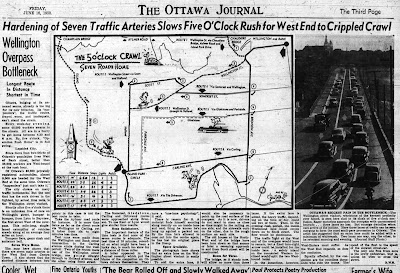



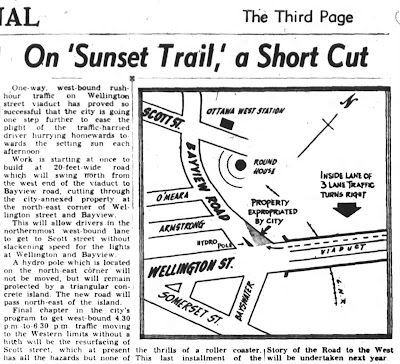
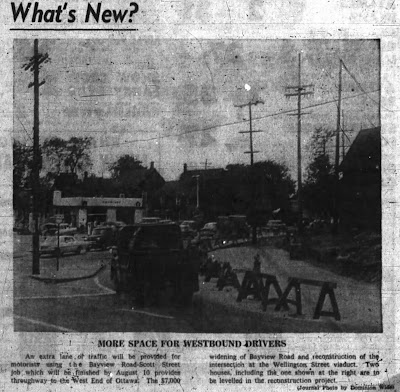
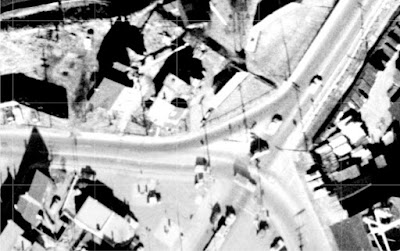
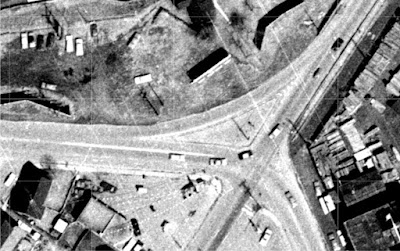
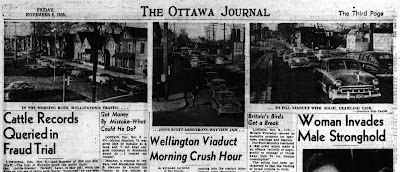







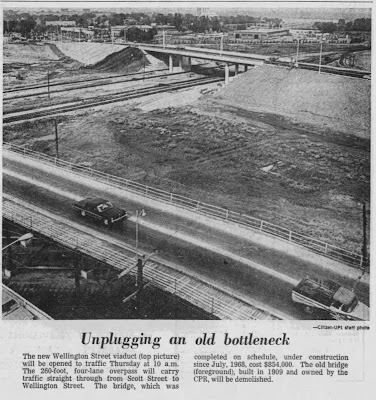
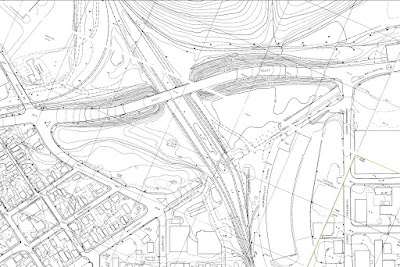
No comments:
Post a Comment